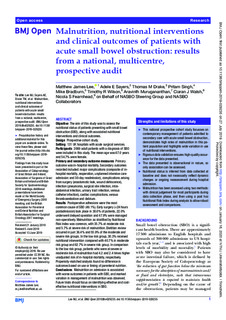| dc.contributor.author | NASBO, NASBO Collaborators | |
| dc.contributor.author | Bolkan, Håkon Angell | |
| dc.date.accessioned | 2020-01-17T06:55:46Z | |
| dc.date.available | 2020-01-17T06:55:46Z | |
| dc.date.created | 2020-01-16T15:48:11Z | |
| dc.date.issued | 2019 | |
| dc.identifier.citation | BMJ Open. 2019, 9 (7) | nb_NO |
| dc.identifier.issn | 2044-6055 | |
| dc.identifier.uri | http://hdl.handle.net/11250/2636716 | |
| dc.description.abstract | Objective The aim of this study was to assess the nutritional status of patients presenting with small bowel obstruction (SBO), along with associated nutritional interventions and clinical outcomes.
Design Prospective cohort study.
Setting 131 UK hospitals with acute surgical services.
Participants 2069 adult patients with a diagnosis of SBO were included in this study. The mean age was 67.0 years and 54.7% were female.
Primary and secondary outcome measures Primary outcome was in-hospital mortality. Secondary outcomes recorded included: major complications (composite of in-hospital mortality, reoperation, unplanned intensive care admission and 30-day readmission), complications arising from surgery (anastomotic leak, wound dehiscence), infection (pneumonia, surgical site infection, intra-abdominal infection, urinary tract infection, venous catheter infection), cardiac complications, venous thromboembolism and delirium.
Results Postoperative adhesions were the most common cause of SBO (49.1%). Early surgery (<24 hours postadmission) took place in 30.0% of patients, 22.0% underwent delayed operation and 47.9% were managed non-operatively. Malnutrition as stratified by Nutritional Risk Index was common, with 35.7% at moderate risk and 5.7% at severe risk of malnutrition. Dietitian review occurred in just 36.4% and 55.9% of the moderate and severe risk groups. In the low risk group, 30.3% received nutritional intervention compared with 40.7% in moderate risk group and 62.7% in severe risk group. In comparison to the low risk group, patients who were at severe or moderate risk of malnutrition had 4.2 and 2.4 times higher unadjusted risk of in-hospital mortality, respectively. Propensity-matched analysis found no difference in outcomes based on use or timing of parenteral nutrition.
Conclusions Malnutrition on admission is associated with worse outcomes in patients with SBO, and marked variation in management of malnutrition was observed. Future trials should focus on identifying effective and cost-effective nutritional interventions in SBO. | nb_NO |
| dc.language.iso | eng | nb_NO |
| dc.publisher | BMJ Publishing Group | nb_NO |
| dc.rights | Navngivelse-Ikkekommersiell 4.0 Internasjonal | * |
| dc.rights.uri | http://creativecommons.org/licenses/by-nc/4.0/deed.no | * |
| dc.title | Malnutrition, nutritional interventions and clinical outcomes of patients with acute small bowel obstruction: results from a national, multicentre, prospective audit | nb_NO |
| dc.type | Journal article | nb_NO |
| dc.type | Peer reviewed | nb_NO |
| dc.description.version | publishedVersion | nb_NO |
| dc.source.volume | 9 | nb_NO |
| dc.source.journal | BMJ Open | nb_NO |
| dc.source.issue | 7 | nb_NO |
| dc.identifier.doi | 10.1136/bmjopen-2019-029235 | |
| dc.identifier.cristin | 1775148 | |
| dc.description.localcode | Copyright information: © Author(s) (or their employer(s)) 2019. Re-use permitted under CC BY-NC. No commercial re-use. | nb_NO |
| cristin.unitcode | 194,65,15,0 | |
| cristin.unitname | Institutt for klinisk og molekylær medisin | |
| cristin.ispublished | true | |
| cristin.fulltext | original | |
| cristin.qualitycode | 1 | |

